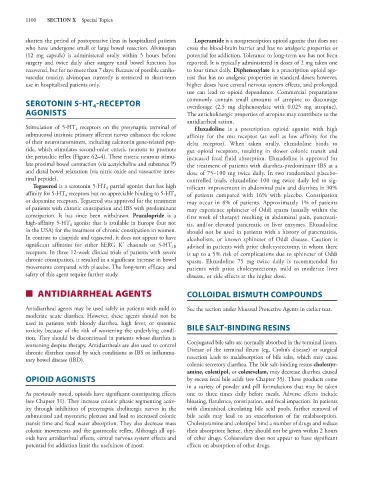Page 1114 - Basic _ Clinical Pharmacology ( PDFDrive )
P. 1114
1100 SECTION X Special Topics
shorten the period of postoperative ileus in hospitalized patients Loperamide is a nonprescription opioid agonist that does not
who have undergone small or large bowel resection. Alvimopan cross the blood-brain barrier and has no analgesic properties or
(12 mg capsule) is administered orally within 5 hours before potential for addiction. Tolerance to long-term use has not been
surgery and twice daily after surgery until bowel function has reported. It is typically administered in doses of 2 mg taken one
recovered, but for no more than 7 days. Because of possible cardio- to four times daily. Diphenoxylate is a prescription opioid ago-
vascular toxicity, alvimopan currently is restricted to short-term nist that has no analgesic properties in standard doses; however,
use in hospitalized patients only. higher doses have central nervous system effects, and prolonged
use can lead to opioid dependence. Commercial preparations
SEROTONIN 5-HT -RECEPTOR commonly contain small amounts of atropine to discourage
4
overdosage (2.5 mg diphenoxylate with 0.025 mg atropine).
AGONISTS The anticholinergic properties of atropine may contribute to the
antidiarrheal action.
Stimulation of 5-HT receptors on the presynaptic terminal of Eluxadoline is a prescription opioid agonist with high
4
submucosal intrinsic primary afferent nerves enhances the release affinity for the mu receptor (as well as low affinity for the
of their neurotransmitters, including calcitonin gene-related pep- delta receptor). When taken orally, eluxadoline binds to
tide, which stimulates second-order enteric neurons to promote gut opioid receptors, resulting in slower colonic transit and
the peristaltic reflex (Figure 62–4). These enteric neurons stimu- increased fecal fluid absorption. Eluxadoline is approved for
late proximal bowel contraction (via acetylcholine and substance P) the treatment of patients with diarrhea-predominant IBS at a
and distal bowel relaxation (via nitric oxide and vasoactive intes- dose of 75–100 mg twice daily. In two randomized placebo-
tinal peptide). controlled trials, eluxadoline 100 mg twice daily led to sig-
Tegaserod is a serotonin 5-HT partial agonist that has high nificant improvement in abdominal pain and diarrhea in 30%
4
affinity for 5-HT receptors but no appreciable binding to 5-HT of patients compared with 16% with placebo. Constipation
3
4
or dopamine receptors. Tegaserod was approved for the treatment may occur in 8% of patients. Approximately 1% of patients
of patients with chronic constipation and IBS with predominant may experience sphincter of Oddi spasm (usually within the
constipation. It has since been withdrawn. Prucalopride is a first week of therapy) resulting in abdominal pain, pancreati-
high-affinity 5-HT agonist that is available in Europe (but not tis, and/or elevated pancreatic or liver enzymes. Eluxadoline
4
in the USA) for the treatment of chronic constipation in women. should not be used in patients with a history of pancreatitis,
In contrast to cisapride and tegaserod, it does not appear to have alcoholism, or known sphincter of Oddi disease. Caution is
+
significant affinities for either hERG K channels or 5-HT advised in patients with prior cholecystectomy, in whom there
1B
receptors. In three 12-week clinical trials of patients with severe is up to a 5% risk of complications due to sphincter of Oddi
chronic constipation, it resulted in a significant increase in bowel spasm. Eluxadoline 75 mg twice daily is recommended for
movements compared with placebo. The long-term efficacy and patients with prior cholecystectomy, mild to moderate liver
safety of this agent require further study. disease, or side effects at the higher dose.
■ ANTIDIARRHEAL AGENTS COLLOIDAL BISMUTH COMPOUNDS
Antidiarrheal agents may be used safely in patients with mild to See the section under Mucosal Protective Agents in earlier text.
moderate acute diarrhea. However, these agents should not be
used in patients with bloody diarrhea, high fever, or systemic
toxicity because of the risk of worsening the underlying condi- BILE SALT-BINDING RESINS
tion. They should be discontinued in patients whose diarrhea is
worsening despite therapy. Antidiarrheals are also used to control Conjugated bile salts are normally absorbed in the terminal ileum.
chronic diarrhea caused by such conditions as IBS or inflamma- Disease of the terminal ileum (eg, Crohn’s disease) or surgical
tory bowel disease (IBD). resection leads to malabsorption of bile salts, which may cause
colonic secretory diarrhea. The bile salt-binding resins cholestyr-
amine, colestipol, or colesevelam, may decrease diarrhea caused
OPIOID AGONISTS by excess fecal bile acids (see Chapter 35). These products come
in a variety of powder and pill formulations that may be taken
As previously noted, opioids have significant constipating effects one to three times daily before meals. Adverse effects include
(see Chapter 31). They increase colonic phasic segmenting activ- bloating, flatulence, constipation, and fecal impaction. In patients
ity through inhibition of presynaptic cholinergic nerves in the with diminished circulating bile acid pools, further removal of
submucosal and myenteric plexuses and lead to increased colonic bile acids may lead to an exacerbation of fat malabsorption.
transit time and fecal water absorption. They also decrease mass Cholestyramine and colestipol bind a number of drugs and reduce
colonic movements and the gastrocolic reflex. Although all opi- their absorption; hence, they should not be given within 2 hours
oids have antidiarrheal effects, central nervous system effects and of other drugs. Colesevelam does not appear to have significant
potential for addiction limit the usefulness of most. effects on absorption of other drugs.

